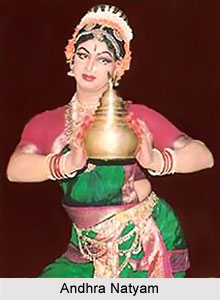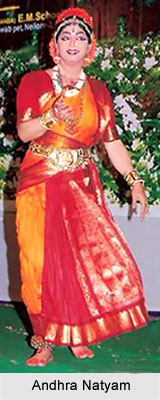 Andhra Natyam is a form of classical dance that originated in the southern part of India, in the Indian state of Andhra Pradesh. This dance form has a long and rich history of 2000 years, but it got lost during the rule of Mughals and British Empire. But fortunately the dance form came to be revived in the 20th century. However, as a result of strong grammatical and structural resemblance to Kuchipudi and Bharatanatyam, this dance form is often considered as a mixture of both.
Andhra Natyam is a form of classical dance that originated in the southern part of India, in the Indian state of Andhra Pradesh. This dance form has a long and rich history of 2000 years, but it got lost during the rule of Mughals and British Empire. But fortunately the dance form came to be revived in the 20th century. However, as a result of strong grammatical and structural resemblance to Kuchipudi and Bharatanatyam, this dance form is often considered as a mixture of both.
Origin of Andhra Natyam
The Andhra Natyam dance form has been derived from numerous classical dance forms and has close similarities with Kuchipudi and Bharatanatyam, including the older dance styles like Dasiattam, Kacherittam, Chinnamelam. It can be said that this dance form actually originated from temples, but it is also performed by courtesans known as Kalavantulu in Telugu, and also in open-air public performances well-known as Kalopam are a part of Andhra Natyam.
About Andhra Natyam
The classical dance of southern India is mainly divided into two major categories. They are Natya Melamu and Nattuva Melamu. While the former is performed by men, the latter is performed solo by women. Dance forms like Mohiniattam, Odissi and Bharatnatyam follow the tradition of Nattuva Melamu tradition. The Kuchipudi dance style follows the Natya Melamu tradition.
Nattuva Melamu is a dance style which is greatly performed by the women flocks and is mainly adapted in a classical dance form which is called Andhra Natyam. Though the name sounds to be new, but the history of this dance goes back a long way, and is as old as the Telugu culture itself.
 Prior to being called Andhra Natyam, this dance form was referred to as Kelika Darbaru, Kaccheri, Mejuvani etc. Abhinaya and dance were both an integral part of the dance in the ancient times. The main reason for calling it as Andhra Natyam is because it is performed in many temples, king`s courts and in local gatherings.
Prior to being called Andhra Natyam, this dance form was referred to as Kelika Darbaru, Kaccheri, Mejuvani etc. Abhinaya and dance were both an integral part of the dance in the ancient times. The main reason for calling it as Andhra Natyam is because it is performed in many temples, king`s courts and in local gatherings.
In the state of Andhra Pradesh, this dance form has three distinct features and they are as follows:
Aradhana Nrityam (Temple Dance)
The Upanishads and Vedas that helps evoke bhakti rasa is the main source of Agama Sastra. Construction of temple, Devata Pratishha, Aradhana, Puja Kramam is classical dance and music. Agama Sastra explains this tradition is extensive detail, including narrative of the types of instruments used and how the poetry needs to be composed. Worship or Puja when done with music or dance is called "Rangabhogamu".
Asthana Nrityam (Dance in Kings Courts)
Asthana Narthakis (court dancers) or Raja Narthakis are cultured, well educated in poetry, literature, arts including dance and music and politics. They perform dance in the king`s court amidst poets, scholars, royal visitors and other experts. These Raja Narthakis have to be constantly on their toes and need to improvise at all levels in order to keep the King and his subjects engrossed with the music and dance. In many historical examples it is very well noted that these Raja Narthakis are well respected among the people.
Prabandha Nrityam (Dance for general audience)
In order to ensure people can under the mythology, culture and tradition of India better, many dance performances were based on well known mythological tales. Dances that were mainly choreographed for such occasion are known as Prabhandhu Nartanamu. Such dances were also used as a source of making political and cultural statements.
This dance form is essentially performed by females, characterised by rich footwork and Abhinaya. The musical instruments accompanying the dance include Mridangam, Manjira, Veena, the Violin, Venu, Tanpura, Surpeti, and Kanjira




